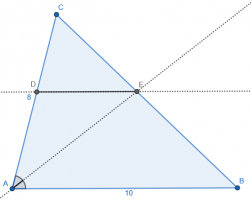I am doing some extra work over the summer break but l am stuck with this question.
In the triangle ABC, two sides have the lengths: AB = 10, AC = 8. The bisector of the angle BAC intersects BC at point E. A line is drawn through point E parallel to side AB, intersecting side AC at point D. Calculate DE.
I sketched a right triangle ( it doesn’t say whether it is or isn’t) as shown in the attachment. Can anyone suggest where I go from here please.

In the triangle ABC, two sides have the lengths: AB = 10, AC = 8. The bisector of the angle BAC intersects BC at point E. A line is drawn through point E parallel to side AB, intersecting side AC at point D. Calculate DE.
I sketched a right triangle ( it doesn’t say whether it is or isn’t) as shown in the attachment. Can anyone suggest where I go from here please.


